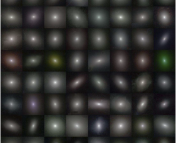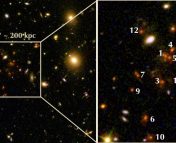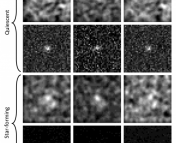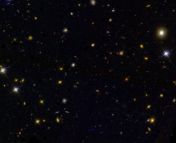Title: A dynamically cold disk in the early universe
Authors: F. Rizzo, S. Vegetti, D. Powell, F. Fraternali, J. P. McKean, H. R. Stacey & S. D. M. White
First Author’s Institution: Max-Planck Institute for Astrophysics
Status: Accepted to Nature, open access on ArXiv
In the nearby universe we see the so-called “Hubble Sequence” of galaxies: gas-rich, blue, star-forming spirals and massive, red, quiescent ellipticals. Theory predicts that the latter elliptical galaxies are dominated by old stellar populations formed in long-gone episodes of star-formation and are destined to slowly burn through until the last M-type dwarf perishes.
But how did the most massive ellipticals we see in our local universe get this way? The leading theory is that they were some of the first galaxies to form, giving them lots of time to grow. They began as extraordinarily dusty galaxies rapidly forming stars from turbulent swarms of gas. Soon their star formation ceased, due to processes still uncertain, although probably due a central supermassive black hole (being fed by the same gas which formed the stars) unleashing lots of energy, expelling or heating up gas which would otherwise be used to continue star-formation, all within the first 3 billion years. Quite a pace! From here, mergers with other galaxies are expected to contribute the bulk of the mass growth from run-of-the-mill ellipticals in the early universe to the massive ones we see today.
In today’s astrobite, we dissect an observation of an eerily mature galaxy from the first 1 billion years which has stopped forming stars, in stark contrast with this picture.
The galaxy creatively named SPT0418-47 was discovered by the South Pole Telescope as an extremely far-infrared luminous source. Follow up with spatially-resolved ALMA interferometric imaging showed a remarkable but strange ring-like galaxy. However, the shape is misleading. This ring is the result of the light from SPT0418-47, seen when the universe was a mere 1.5 Gyr old (z~4), being gravitationally lensed by a more nearby galaxy (z~0.2). The lensing here is absolutely key to unlocking the mysteries of this galaxy, as it allows us to study its spatial structure in remarkable detail otherwise unachievable for un-lensed galaxies at these great distances
Figure 1 shows the image of the galaxy, as well as the coherent velocity and velocity dispersion (i.e. random motions) of the interstellar medium (as probed by the luminous [C II] line).
Great effort was taken to reconstruct what the galaxy would look like without the distortions caused by lensing, using a sophisticated three-dimensional lens-kinematic modeling technique. The result is shown below in Figure 2, with the same information which is distorted in Figure 1.
The galaxy’s shape is consistent with those of classic, bulge-dominated spiral galaxies which we see commonly in the nearby universe. It has a disk component as well, which is clearly undergoing coherent rotation as shown in panel (e). The central bulge, however, is dominated by random motions with a high velocity dispersion.
Although the galaxy’s main properties such as stellar mass, size, and gas fraction are consistent with both theory and (unresolved) observations at this redshift, there are two very striking differences.
Firstly, they measured the ratio of coherent velocity to velocity dispersion which probes whether the motions of the gas are due to coherent motion as seen in spirals or random motions as seen in ellipticals and merging galaxies. They find v/ = 9.7 where the coherent velocity dominates to form a “dynamically cold” disc, in excess of the expectation from theory (v/
<3).
Secondly, they derived the Toomre Q parameter, related to stabilities in the disk against collapse. If Q > 1 then no instabilities will arise in the disk because the differential rotation is too high for overdensities to be stable. However, if Q 1 then the conditions are ripe for instabilities to grow and form clumps of gas which will lead to star-formation. They find a value of Q~1, indicating an unstable disk prone to star-formation.
The observance of a coherent disk structure together with a high-Q parameter demonstrates that although SPT0418-47 has a tendency for clumpy regions to develop, the overall shape of this dusty star-forming galaxy is actually a rather ordinary disk. These two remarkable measurements indicate that this galaxy is undergoing rapid star-formation without the turbulent motion typically ascribed to dusty star-forming galaxies. The significance of this finding is shown in Figure 3, where the v/ result is shown to be totally contrary to analytical predictions of dusty star-forming galaxies having clumpy, dispersion-dominated, and chaotic shapes driven by mergers. Thanks to SPT0418-47, we are beginning to see the full picture.
The unprecedented spatial resolution provided by gravitational lensing allows us to peer back into time, and witness a galaxy totally contrary to our theories of galaxy formation. Instead of a messy, turbulent, and rapidly star-forming galaxy driven by chaotic motions, feedback, and mergers, we see a rather ordinary disk galaxy which has sustained star-formation but no obvious signs of merging or disruption, contrary to the prevailing picture of the first galaxies. And to think, all of this for 21 minutes of telescope time!
Editor: Gloria Fonseca Alvarez
Featured image credit: ALMA (ESO/NAOJ/NRAO), Rizzo et al.




